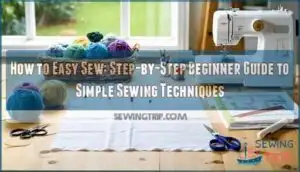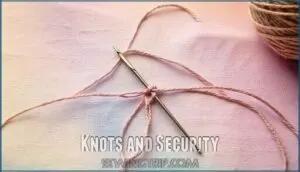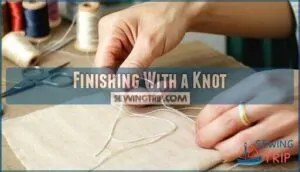This site is supported by our readers. We may earn a commission, at no cost to you, if you purchase through links.

You’ll master straight stitches by maintaining 2-3mm spacing and matching thread to fabric weight. Start with simple knots on the fabric’s wrong side, then practice basic stitches like running stitch for seams and backstitch for strength.
Pre-wash your fabric to prevent shrinking, and don’t rush—steady speed creates cleaner results. Change needles regularly to avoid skipped stitches.
With these fundamentals, you’ll confidently tackle hemming, mending, and basic alterations. The real magic happens when you discover how different stitch combinations transform simple fabric into professional-looking projects.
Table Of Contents
Key Takeaways
- Gather essential tools first – You’ll need sharp needles, quality fabric scissors, a pincushion, measuring tape, and marking pens to set yourself up for success.
- Master straight stitches with consistency – Keep your stitches evenly spaced at 2-3mm intervals and match your thread weight to your fabric for professional results.
- Start with secure knots and proper preparation – Begin on the fabric’s wrong side with firm knots and always pre-wash your fabric to prevent shrinking disasters.
- Focus on control over speed – You’ll achieve cleaner, more professional-looking projects by maintaining steady, deliberate stitching rather than rushing through your work.
Basic Sewing Tools
When you’re setting out to master sewing, building a trusty sewing kit is your first step.
Gather a handful of sharp sewing needles—choose ones that fit your fabric and project for smoother stitching. Don’t skimp on fabric scissors; kitchen scissors just won’t cut it (literally).
Right tools matter—sharp needles and real fabric scissors make all the difference in your sewing success
A classic pincushion keeps pins handy so you won’t find them with your foot. Measuring tools, like a flexible measuring tape, save you from wonky seams and awkward fits.
Marking pens help transfer pattern details straight onto fabric, making sure every cut and stitch hits the mark. Stock up on quality thread types, since weak thread can make your seams snap faster than a rubber band.
Understanding basic sewing supplies is essential for a successful sewing project. With the right sewing tools, you’ll move from rookie to ruler of the craft in no time.
Creating Straight Stitches
Every straight stitch is its own tiny victory. Before you begin, poke your needle through the far edge of your fabric or pattern template. This is where consistency starts.
Stitch Length matters—a neat row is made by spacing stitches evenly, about 2–3 mm each for most clothing projects. Your Thread Choice is just as important; match the thread’s weight to your fabric for smooth sailing. Keep Fabric Tension balanced. Too tight, and the fabric puckers; too loose, and everything unravels.
As you sew, Hand Guidance keeps your lines straight. Don’t rush; steady Sewing Speed always wins over fast, frantic stabbing (ask me how I know!). Aim for control, not speed.
Here’s how to master straight stitches:
- Mark straight guidelines on fabric.
- Choose a sharp needle and matching thread.
- Practice on scraps first.
- Check tension after every few stitches.
- Celebrate each even row—perfection is over-rated!
Mastering sewing basic straight stitches requires patience and practice to achieve professional results.
Knots and Security
Straight stitches are only as strong as the knots holding them together, so it’s time to learn the secret handshake of Secure Threads—knot tying.
If you’ve ever watched your hard work unravel like a bad sweater, you know why locking those Thread Ends is a must.
The basics are simple: start on the wrong side of your fabric, poke your needle through, and pull until you’ve got a nice loop.
Thread your needle up into that circle to create a firm knot.
For good measure, repeat it a couple more times.
Different fabrics may need extra assurance, like a quick backstitch or switching to a slip stitch for extra security.
Mastering sewing knots is one of those sewing basics you’ll use daily.
Understanding knot tying techniques is essential for achieving professional results.
Get comfortable with knot tying, and your sewing techniques will go from frail to fail-proof.
Happy stitching, and don’t forget—a little knot goes a long way!
Other Useful Stitches
Ready to level up your sewing game? Mastering a handful of stitches opens up serious creative freedom.
The zigzag stitch keeps those elastic waistbands secure and crisp. A slip stitch can close seams invisibly, perfect for plush or pillow projects. Love decorative edges? Try a bold blanket stitch or add character with a whip stitch.
Stitch smooth with these tips:
- Swap thread thickness to fit your project.
- Test stitches on scrap fabric first.
- Enjoy every “oops”—mistakes are part of the journey!
To improve your sewing skills, practice using hand stitching techniques to finish raw edges and seams.
Tips for Successful Sewing
Let’s move on from stitches you might use to a few tried-and-true sewing tips that set up any project for success.
Start by pre-washing your fabric—even if it smells fresh off the bolt—since Fabric Preparation can dodge shrinking headaches down the road.
Take a good look at Fabric Choice: light cotton makes easy sewing projects simpler for beginners, while heavier fabrics can test your patience (and your scissors).
Keep an eye on your Sewing Speed; slow and steady wins the seam here.
Practicing straight lines and paying attention to Thread Tension gives you cleaner, more professional results.
Don’t forget: using the right needle for your fabric prevents skipped stitches.
Change it out regularly—think of it like swapping out worn sneakers.
Practice may not make perfect, but it does make “learn to sew” a lot more fun.
Understanding thread selection tips is essential for achieving the desired outcome in your sewing projects.
- Experiment with different fabrics to build confidence and master easy sewing tutorials.
Finishing With a Knot
After your sewing tips are locked in, you’ll need to properly finish your work. Knot tying isn’t just about stopping threads from unraveling—it’s your secret weapon for thread security that lasts.
Here’s the straightforward approach: create a small loop with your thread near the fabric surface, then pull your needle through this loop twice before tightening. This double-wrap method gives you secure stitching that won’t budge, even with heavy use.
For sewing ends that need extra strength, try the quilter’s knot. Wrap the thread around your needle three times, then pull the needle through while holding the wraps. You’ll get a bigger knot that anchors beautifully in thicker fabrics.
When working on fabric closure projects like pillow covers, position your final sewing knots between fabric layers. This keeps them hidden while maintaining that professional look. Remember, good hand sewing isn’t about perfect stitches—it’s about smart finishing techniques. These sewing instructions will serve you well across countless projects, turning wobbly beginner attempts into confident, lasting results. Mastering the sewing knot technique is essential for achieving a secure and durable finish.
Running & Basting Stitches
Now you’ve mastered knots, it’s time to tackle two powerhouse hand sewing stitches that’ll become your go-to techniques. The running stitch and basting stitch might look similar, but they serve different purposes in your sewing toolkit.
The running stitch creates your basic straight stitch by weaving the needle in and out at even intervals. Think of it as drawing a dotted line through fabric. Space your stitches about 1/8 to 1/4 inch apart for secure seams. This stitch works perfectly for joining fabric pieces or creating decorative borders.
Basting stitches are basically looser running stitches with longer gaps (1/2 to 1 inch). They’re your temporary helpers for fitting adjustments or holding layers together before permanent stitching.
Key basting tips for success:
- Use contrasting thread colors for easy removal later
- Keep fabric tension light to prevent puckering
- Make stitch length consistent but don’t stress perfection
Both beginner sewing stitches give you control over fabric manipulation while building your hand sewing confidence through repetitive practice. Understanding the simple running stitch tutorial is vital for mastering these fundamental techniques.
Frequently Asked Questions (FAQs)
What is the easiest thing for a beginner to sew?
Start with a simple envelope pillow cover. You’ll need just two fabric squares, basic straight stitches, and no zippers. It’s quick, forgiving, and gives you instant satisfaction while building confidence.
Can I self teach myself to sew?
You’ll definitely crack the code of needle and thread on your own.
Self-teaching sewing is totally achievable with practice, patience, and good online tutorials.
Start simple, embrace mistakes as learning moments, and you’ll be stitching confidently.
What’s the hardest thing to sew?
Custom clothing, structured jackets, and fitted blazers challenge you most. They demand precise measurements, complex construction techniques, and perfect fit adjustments that’ll test every skill you’ve developed.
Should I learn to hand sew first?
Don’t put all your eggs in one basket—learning hand sewing first gives you essential foundation skills.
You’ll understand tension, stitch mechanics, and fabric behavior before tackling machines.
Hand sewing builds patience and precision that’ll make machine sewing much easier later.
What are some common mistakes to avoid when creating straight stitches?
Avoid uneven tension – don’t pull too tight or leave loose. Keep consistent stitch length by marking your finger. Maintain straight lines using fabric guides or rulers.
How do I choose the right needle for my sewing project?
Like threading a needle through life’s fabric, choosing the right needle determines whether your project soars or snags.
Match needle size to fabric weight: size 9-11 for lightweight fabrics, 14-16 for medium weight, 18-19 for heavy materials like denim or canvas, which can make or break a project, depending on the fabric weight.
Can you provide some tips for preventing fabric fraying while sewing?
Cut fabric on the grainline to prevent stretching. Use sharp scissors for clean edges. Apply fray check solution to cut edges, or zigzag stitch raw seams immediately after cutting.
What are some alternative methods for securing fabric besides knots?
You can use backstitching at thread ends, basting with longer temporary stitches, whipstitching for hems, or slipstitching for invisible closures. Each method secures fabric differently without traditional knots.
How do you choose the right fabric type?
Choosing fabric is like selecting the foundation for your home—it determines everything that follows.
For beginners, cotton and linen offer forgiveness and ease.
Check your project’s needs: sturdy canvas for bags, stretchy knits for fitted garments, and delicate fabrics for special occasions.
What causes thread to keep breaking while sewing?
Thread breakage usually happens when you’re using old or low-quality thread, threading your needle incorrectly, or pulling too hard while stitching. Check your thread quality and ease up on tension.
Conclusion
Picture yourself weeks from now, confidently repairing torn clothes and creating beautiful handmade gifts.
Learning how to easy sew transforms everyday fabric challenges into creative victories. You’ve mastered the essential tools, perfected your stitches, and discovered the satisfaction of self-reliance.
Remember, every expert started exactly where you’re now—one stitch at a time. Keep practicing these fundamentals, stay patient with yourself, and soon you’ll wonder how you ever lived without this invaluable skill.
- https://www.sewcanshe.com/blog/how-to-sew-easy-baskets-with-10-squares-layer-cake-leftover-project
- https://www.sewmuchado.com/tutorial-felt-flash-cards-memory-game/
- https://happiestcamper.com/how-to-make-a-reversible-table-runner-for-beginners/
- https://abeautifulmess.com/2019/11/reusable-makeup-wipe-diy.html
- https://sewcanshe.com/2014-11-13-easy-peasy-pincushions-with-baby-pom-poms/









